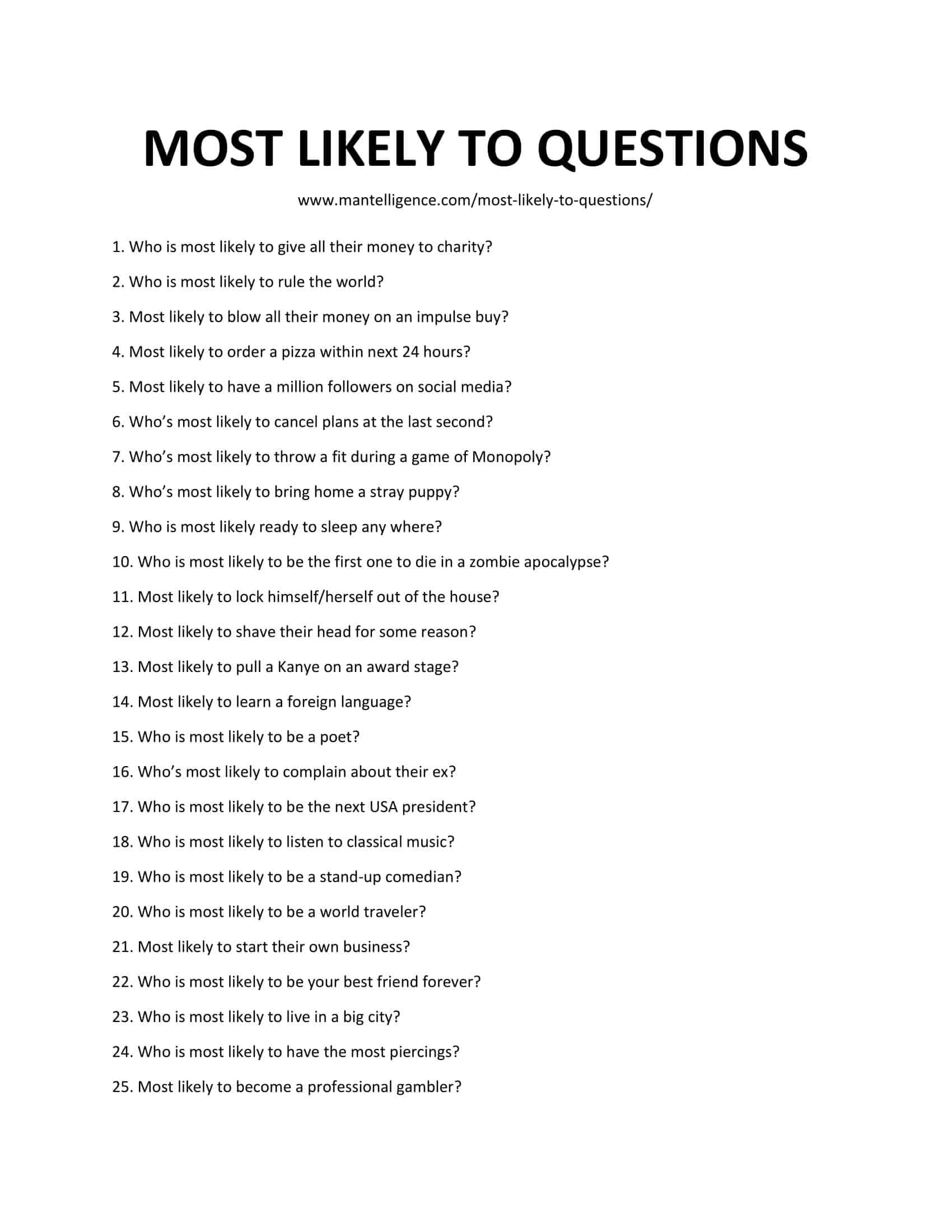Whether you’re planning a party, a family gathering, or a casual get-together with friends, “Who’s Most Likely to” questions can add an element of fun and laughter to your event. This engaging game is perfect for breaking the ice, sparking interesting conversations, and getting to know each other better. In this comprehensive guide, we will delve into everything you need to know about “Who’s Most Likely to” questions, from their origins to their impact on social dynamics. Let’s dive in!
Key Takeaways
Before we explore the details, here are some Key Takeway about “Who’s Most Likely to” questions:
- Engaging and Fun: These questions are designed to be entertaining and thought-provoking.
- Versatile: Suitable for various occasions, including parties, family gatherings, and team-building events.
- Easy to Play: No special equipment or preparation is needed, making it an accessible game for everyone.
- Great for Bonding: Helps people connect, share stories, and learn more about each other.
- Customizable: Questions can be tailored to suit different groups and contexts.
Involving Parties?
The beauty of “Who’s Most Likely to” questions lies in their inclusivity. Anyone can participate, making it a game that bridges age gaps and social circles. Whether you are playing with family members, friends, or colleagues, the game encourages everyone to join in. Here’s a breakdown of the key participants:
Friends
Playing with friends can lead to hilarious revelations and deepen your understanding of each other. It’s a great way to reminisce about shared experiences and inside jokes.
Family
When played with family, the game can uncover funny childhood stories and highlight family dynamics. It’s a wonderful way to bond with relatives of all ages.
Colleagues
In a professional setting, “Who’s Most Likely to” questions can serve as an icebreaker during team-building activities. It helps colleagues see each other in a different light and fosters a sense of camaraderie.
Events Timeline
The concept of “Who’s Most Likely to” questions has evolved over time. Here’s a brief timeline highlighting its journey:
Early 2000s
The game started gaining popularity in informal settings, especially among teenagers and young adults. It was often played during sleepovers and parties.
2010s

With the rise of social media, the game found a new platform. People began sharing their “Who’s Most Likely to” questions and answers online, making it a viral trend.
2020s
The game saw a resurgence during the COVID-19 pandemic as people looked for virtual ways to connect. Online versions and apps featuring “Who’s Most Likely to” questions became widely popular.
How Does This Impact Them?
The impact of “Who’s Most Likely to” questions extends beyond mere entertainment. Here are some notable effects:
Personal Relationships
Playing the game can strengthen personal relationships by fostering open communication and mutual understanding. It encourages participants to share their thoughts and feelings, leading to deeper connections.
Professional Environment
In a professional setting, the game can break down barriers and promote teamwork. It allows colleagues to see each other as individuals rather than just coworkers, enhancing collaboration and morale.
Public and Media Reactions
“Who’s Most Likely to” questions have garnered significant attention from the public and media alike. Here are some notable reactions:
Social Media Buzz
Platforms like TikTok, Instagram, and Twitter are flooded with videos and posts featuring “Who’s Most Likely to” questions. These posts often go viral, showcasing the game’s widespread appeal.
Media Coverage
Various media outlets have covered the game, highlighting its popularity and impact. Articles, blog posts, and even TV segments have explored how the game brings people together and offers a fun way to pass the time.
Future Prospects and Upcoming Plans
The future of “Who’s Most Likely to” questions looks promising, with several exciting developments on the horizon:
New Variations
As the game continues to evolve, we can expect new variations and themes to emerge. These could include tailored versions for different age groups, cultures, and interests.
Technological Integration
With advancements in technology, we may see more interactive and immersive versions of the game. Virtual reality (VR) and augmented reality (AR) could offer new ways to play and experience “Who’s Most Likely to” questions.
Educational Applications
There is potential for the game to be used in educational settings to promote social skills, critical thinking, and empathy among students. Educators could incorporate the game into their teaching methods to make learning more engaging.
In conclusion, “Who’s Most Likely to” questions are a versatile and enjoyable way to bring people together. Whether you’re looking to break the ice, spark interesting conversations, or simply have a good laugh, this game has something to offer. Its inclusive nature, ease of play, and potential for customization make it a favorite for various occasions. As the game continues to evolve and gain popularity, we can look forward to even more creative and exciting ways to enjoy it. So, the next time you’re planning a gathering, don’t forget to include “Who’s Most Likely to” questions for a memorable and fun experience!


